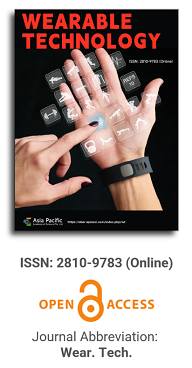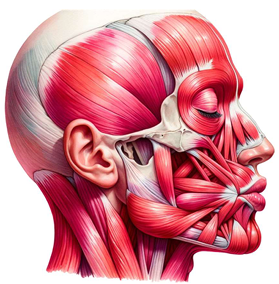

This paper delves deeply into the innovative realm of integrating human emotions with wearable technology. The primary focus is on the conceptualization and development of a kiss transfer device that harnesses the power of wearable technology to bridge the physical gap in human-human interactions. By investigating the intricate nuances of the human-human kissing process, the research seeks to replicate this intimate gesture through a technological medium. The paper not only elaborates on the anatomy, evolution, and hormonal dynamics of kissing but also underscores the transformative potential of wearable technology in capturing and transmitting these intimate moments. This exploration opens up new horizons for long-distance relationships, offering a tangible touchpoint that goes beyond traditional communication methods. Through this pioneering work, the research positions wearable technology as not just a tool for communication but as an extension of our human emotions and expressions.

Health and biosensor technology—A revolution underway for the well-being of the population
Vol 4, Issue 1, 2023
Download PDF
Abstract
This document mentions characteristics of portable devices that highlight their applicability in healthcare because they fundamentally allow monitoring outside hospital institutions and allow the prediction of health events. This writing is achieved with the review of updated information available in the world scientific literature. Additionally, the challenges and disadvantages associated with the implementation of wearable sensors are shown. The aim of the above is to highlight that portable devices improve medical care in a wide variety of environments, but are particularly useful for the remote management of pathologies.
Keywords
References
- Dunn J, Runge R, Snyder M. Wearables and the medical revolution. Personalized Medicine. 2018; 15(5): 429-448. doi: 10.2217/pme-2018-0044
- Guillodo E, Lemey C, Simonnet M, et al. Clinical Applications of Mobile Health Wearable–Based Sleep Monitoring: Systematic Review. JMIR mHealth and uHealth. 2020; 8(4): e10733. doi: 10.2196/10733
- Sharma A, Badea M, Tiwari S, et al. Wearable Biosensors: An Alternative and Practical Approach in Healthcare and Disease Monitoring. Molecules. 2021; 26(3): 748. doi: 10.3390/molecules26030748
- Vijayan V, Connolly JP, Condell J, et al. Review of Wearable Devices and Data Collection Considerations for Connected Health. Sensors. 2021; 21(16): 5589. doi: 10.3390/s21165589
- Bastidas-Pacheco G, Bastidas-Delgado D, Bastidas-Delgado G. COVID-19: a challenge for smart cities in the public health decalogue (Spanish). IPSA Scientia, revista científica multidisciplinaria. 2022; 7(Sup. 1): 39-50. doi: 10.25214/27114406.1428
- Bayoumy K, Gaber M, Elshafeey A, et al. Smart wearable devices in cardiovascular care: where we are and how to move forward. Nature Reviews Cardiology. 2021; 18(8): 581-599. doi: 10.1038/s41569-021-00522-7
- Tamsin M. Wearable biosensor technologies. International Journal of Innovation and Scientific Research. 2015; 13: 697-703.
- Bastidas G, Bastidas-Delgado G. Nanobiotechnology in the treatment of Leishmania spp. Biotempo Journal. 2020; 17(2): 321-333.
- Bastidas G, Bastidas-Delgado G. COVID-19 pandemic in smart cities. Angeles Group Medical Record. 2020; 18(4): 443-444.
- Lim WK, Davila S, Teo JX, et al. Beyond fitness tracking: The use of consumer-grade wearable data from normal volunteers in cardiovascular and lipidomics research. PLOS Biology. 2018; 16(2): e2004285. doi: 10.1371/journal.pbio.2004285
- Bastidas G, Rojas A, Bastidas D. Internet of things: an interesting option for the future of public health. EduMecentro Journal. 2022; 14: e2184.
- Lu L, Zhang J, Xie Y, et al. Wearable Health Devices in Health Care: Narrative Systematic Review. JMIR mHealth and uHealth. 2020; 8(11): e18907. doi: 10.2196/18907
- Bastidas G, Baéz M, Bastidas D. Telehealth in Education and Research in Primary Care in Pandemic: COVID-19 Case. International Journal of Clinical and Experimental Medicine Research. 2021; 5(3): 416-420. doi: 10.26855/ijcemr.2021.07.029
- Claudio D, Velázquez MA, Bravo-Llerena W, et al. Perceived Usefulness and Ease of Use of Wearable Sensor-Based Systems in Emergency Departments. IIE Transactions on Occupational Ergonomics and Human Factors. 2015; 3(3-4): 177-187. doi: 10.1080/21577323.2015.1040559
- Kamišalić A, Fister I, Turkanović M, et al. Sensors and Functionalities of Non-Invasive Wrist-Wearable Devices: A Review. Sensors. 2018; 18(6): 1714. doi: 10.3390/s18061714
- Boscari F, Galasso S, Acciaroli G, et al. Head-to-head comparison of the accuracy of Abbott FreeStyle Libre and Dexcom G5 mobile. Nutrition, Metabolism and Cardiovascular Diseases. 2018; 28(4): 425-427. doi: 10.1016/j.numecd.2018.01.003
- Massa GG, Gys I, Op ‘t Eyndt A, et al. Evaluation of the FreeStyle® Libre Flash Glucose Monitoring System in Children and Adolescents with Type 1 Diabetes. Hormone Research in Paediatrics. 2018; 89(3): 189-199. doi: 10.1159/000487361
- Heinemann L, Freckmann G, Ehrmann D, Faber-Heinemann G, Guerra S, Waldenmaier D, et al. Real-time continuous glucose monitoring in adults with type 1 diabetes and impaired hypoglycaemia awareness or severe hypoglycaemia treated with multiple daily insulin injections (HypoDE): A multicentre, randomised controlled trial. Lancet. 2018; 391(10128): 1367-1377.
- Kim J, Kim M, Lee MS, et al. Wearable smart sensor systems integrated on soft contact lenses for wireless ocular diagnostics. Nature Communications. 2017; 8(1). doi: 10.1038/ncomms14997
- Park J, Kim J, Kim SY, et al. Soft, smart contact lenses with integrations of wireless circuits, glucose sensors, and displays. Science Advances. 2018; 4(1). doi: 10.1126/sciadv.aap9841
- Schwartz FL, Marling CR, Bunescu RC. The Promise and Perils of Wearable Physiological Sensors for Diabetes Management. Journal of Diabetes Science and Technology. 2018; 12(3): 587-591. doi: 10.1177/1932296818763228
- Vandenberk T, Stans J, Mortelmans C, et al. Clinical Validation of Heart Rate Apps: Mixed-Methods Evaluation Study. JMIR mHealth and uHealth. 2017; 5(8): e129. doi: 10.2196/mhealth.7254
- Solomon MD, Yang J, Sung SH, et al. Incidence and timing of potentially high-risk arrhythmias detected through long term continuous ambulatory electrocardiographic monitoring. BMC Cardiovascular Disorders. 2016; 16(1). doi: 10.1186/s12872-016-0210-x
- Yin H, Jha NK. A Health Decision Support System for Disease Diagnosis Based on Wearable Medical Sensors and Machine Learning Ensembles. IEEE Transactions on Multi-Scale Computing Systems. 2017; 3(4): 228-241. doi: 10.1109/tmscs.2017.2710194
- Lee H, Chung H, Ko H, et al. Dedicated cardiac rehabilitation wearable sensor and its clinical potential. PLOS ONE. 2017; 12(10): e0187108. doi: 10.1371/journal.pone.0187108
- Kim J, Nakamura T, Kikuchi H, et al. Co-Variation of Depressive Mood and Locomotor Dynamics Evaluated by Ecological Momentary Assessment in Healthy Humans. PLoS ONE. 2013; 8(9): e74979. doi: 10.1371/journal.pone.0074979
- Nwankwo T, Yoon S, Burt V, Gu Q. Hypertension among adults in the United States: National Health and Nutrition Examination Survey, 2011-2012. NCHS Data Brief. 2013; (133): 1-8.
- Burkard T, Mayr M, Winterhalder C, et al. Reliability of single office blood pressure measurements. Heart. 2018; 104(14): 1173-1179. doi: 10.1136/heartjnl-2017-312523
- Topouchian J, Agnoletti D, Blacher J, et al. Validation of four devices: Omron M6 Comfort, Omron HEM-7420, Withings BP-800, and Polygreen KP-7670 for home blood pressure measurement according to the European Society of Hypertension International Protocol. Vasc Health Risk Manag. 2014; 10: 33-44.
- Mukkamala R, Hahn JO, Inan OT, et al. Toward Ubiquitous Blood Pressure Monitoring via Pulse Transit Time: Theory and Practice. IEEE Transactions on Biomedical Engineering. 2015; 62(8): 1879-1901. doi: 10.1109/tbme.2015.2441951
- Dua M, Malhotra L, Navalgund A, et al. Monitoring of gastric myoelectric activity after pancreaticoduodenectomy. Gastroenterology. 2017; 152(5): S1293-S1294.
- Feakins RM. Obesity and metabolic syndrome: pathological effects on the gastrointestinal tract. Histopathology. 2016; 68(5): 630-640. doi: 10.1111/his.12907
- Dagdeviren C, Javid F, Joe P, et al. Flexible piezoelectric devices for gastrointestinal motility sensing. Nature Biomedical Engineering. 2017; 1(10): 807-817. doi: 10.1038/s41551-017-0140-7
- Kaplan KA, Hirshman J, Hernandez B, et al. When a gold standard isn’t so golden: Lack of prediction of subjective sleep quality from sleep polysomnography. Biological Psychology. 2017; 123: 37-46. doi: 10.1016/j.biopsycho.2016.11.010
- Martinez HP, Bengio Y, Yannakakis GN. Learning deep physiological models of affect. IEEE Computational Intelligence Magazine. 2013; 8(2): 20-33. doi: 10.1109/mci.2013.2247823
- Hashemi J, Tepper M, Vallin Spina T, et al. Computer Vision Tools for Low-Cost and Noninvasive Measurement of Autism-Related Behaviors in Infants. Autism Research and Treatment. 2014; 2014: 1-12. doi: 10.1155/2014/935686
- Poh MZ, Loddenkemper T, Reinsberger C, et al. Autonomic changes with seizures correlate with postictal EEG suppression. Neurology. 2012; 78(23): 1868-1876. doi: 10.1212/wnl.0b013e318258f7f1
- Najafi B, Ron E, Enriquez A, et al. Smarter Sole Survival: Will Neuropathic Patients at High Risk for Ulceration Use a Smart Insole-Based Foot Protection System? Journal of Diabetes Science and Technology. 2017; 11(4): 702-713. doi: 10.1177/1932296816689105
- Gia T, Sarker V, Tcarenko I, et al. Energy efficient wearable sensor node for IoT-based fall detection systems. Microprocessors and Microsystems. 2018; 56: 34-46. doi: 10.1016/j.micpro.2017.10.014
- Dietz PM, Vesco KK, Callaghan WM, et al. Postpartum Screening for Diabetes After a Gestational Diabetes Mellitus–Affected Pregnancy. Obstetrics & Gynecology. 2008; 112(4): 868-874. doi: 10.1097/aog.0b013e318184db63
- Nicklas JM, Zera CA, Seely EW, et al. Identifying postpartum intervention approaches to prevent type 2 diabetes in women with a history of gestational diabetes. BMC Pregnancy and Childbirth. 2011; 11(1). doi: 10.1186/1471-2393-11-23
- Vesco KK, Dietz PM, Bulkley J, et al. A system-based intervention to improve postpartum diabetes screening among women with gestational diabetes. American Journal of Obstetrics and Gynecology. 2012; 207(4): 283.e1-283.e6. doi: 10.1016/j.ajog.2012.08.017
- Berglund Scherwitzl E, Gemzell Danielsson K, Sellberg JA, et al. Fertility awareness-based mobile application for contraception. The European Journal of Contraception & Reproductive Health Care. 2016; 21(3): 234-241. doi: 10.3109/13625187.2016.1154143
- Bonafide CP, Jamison DT, Foglia EE. The Emerging Market of Smartphone-Integrated Infant Physiologic Monitors. JAMA. 2017; 317(4): 353. doi: 10.1001/jama.2016.19137
- Tanigasalam V, Vishnu Bhat B, Adhisivam B, et al. Hypothermia detection in low birth weight neonates using a novel bracelet device. The Journal of Maternal-Fetal & Neonatal Medicine. 2018; 32(16): 2653-2656. doi: 10.1080/14767058.2018.1443072
- Rhee H, Belyea MJ, Sterling M, et al. Evaluating the Validity of an Automated Device for Asthma Monitoring for Adolescents: Correlational Design. Journal of Medical Internet Research. 2015; 17(10): e234. doi: 10.2196/jmir.4975
- Pramono RXA, Bowyer S, Rodriguez-Villegas E. Automatic adventitious respiratory sound analysis: A systematic review. PLOS ONE. 2017; 12(5): e0177926. doi: 10.1371/journal.pone.0177926
- Dieffenderfer J, Goodell H, Mills S, et al. Low-Power Wearable Systems for Continuous Monitoring of Environment and Health for Chronic Respiratory Disease. IEEE Journal of Biomedical and Health Informatics. 2016; 20(5): 1251-1264. doi: 10.1109/jbhi.2016.2573286
- Barajas-Carmona JG, Francisco-Aldana L, Morales-Narváez E. Wearable Nanoplasmonic Patch Detecting Sun/UV Exposure. Analytical Chemistry. 2017; 89(24): 13589-13595. doi: 10.1021/acs.analchem.7b04066
- Asimina S, Chapizanis D, Karakitsios S, et al. Assessing and enhancing the utility of low-cost activity and location sensors for exposure studies. Environmental Monitoring and Assessment. 2018; 190(3). doi: 10.1007/s10661-018-6537-2
Supporting Agencies
Copyright (c) 2024 Gilberto Bastidas, Roman Iglesias
License URL: https://creativecommons.org/licenses/by/4.0/

Prof. Zhen Cao
College of Information Science & Electronic Engineering, Zhejiang University
China, China
Processing Speed
-
-
-
- <5 days from submission to initial review decision;
- 62% acceptance rate
-
-
Asia Pacific Academy of Science Pte. Ltd. (APACSCI) specializes in international journal publishing. APACSCI adopts the open access publishing model and provides an important communication bridge for academic groups whose interest fields include engineering, technology, medicine, computer, mathematics, agriculture and forestry, and environment.





